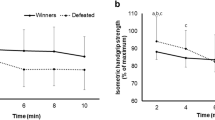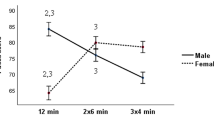Abstract
The analysis of the most decisive factors in performance is fundamental in order to train on these aspects to maximize the chances of success in competition. However, in the field of esports, research that has analyzed performance is scarce and includes various modalities, making it difficult to draw conclusions for a specific esports. Due to the growing interest in League of Legends in recent years, this research focuses on this esports and has the following objectives: a) to analyze the differences in the variables of performance and heat rate (HR) as a function of winning or losing; b) to establish the differences in the HR of the players depending on the role of the player, the involvement of the player in the play, and the team that benefited from each action during the game; and c) to determine the physiological changes that players undergo depending on the type of action performed. Ninety games and 4638 plays of an elite League of Legends team composed of five male players were analyzed. The results showed that tower destruction and kills were the most decisive performance factors in the final result. Furthermore, although no differences in HR were found when comparing games won and lost, differences were observed depending on the player’s participation and the action performed, with actions that directly involved the player and favored the team showing the greatest differences in HR, more specifically the obtaining of neutral objectives (Baron Nashor and Elder Dragon), the destruction of structures closest to the nexus base and the team fights.





Similar content being viewed by others
Data availability statement
The datasets generated and/or analysed during the current study are available in the following link: https://docs.google.com/spreadsheets/d/1zA3DxESiMFbY07UU9rBEIO7012eVvKSC/edit?usp=sharing&ouid=110513782483489263505&rtpof=true&sd=true
References
Ahn J, Collis W, Jenny S (2020) The one billion dollar myth: methods for sizing the massively undervalued esports revenue landscape. Int J Esports 1:1–19 https://www.ijesports.org/article/15/html
Andre T, Walsh S, Valladao S, Cox D (2020) Physiological and Perceptual Response to a Live Collegiate Esports Tournament. Int J Exerc Sci 13:1418–1429
Benum SD, van der Weel FR, van der Meer ALH (2021) In a Heartbeat: Prospective Control of Cardiac Responses for Upcoming Action Demands during Biathlon. Ecol Psychol 33:90–105. https://doi.org/10.1080/10407413.2021.1885979
Blanco A (1994) Hockey sobre patines: niveles de frecuencia cardiaca y lactacidemia en competición y entrenamiento. Apunt Educ Fis y Deport 36:26–36
Bonnar D, Castine B, Kakoschke N, Sharp G (2019) Sleep and performance in Eathletes: for the win! Sleep Heal 5:647–650. https://doi.org/10.1016/j.sleh.2019.06.007
Cohen J (1988) Statistical Power Analysis for the Behavioral Sciences, 2nd edn. Lawrence Erlbaum Associates, Hillsdale
Docherty D (1982) A comparison of heart rate responses in racquet games. Br J Sports Med 16:96–100
Donaldson S (2017) Mechanics and Metagame: Exploring Binary Expertise in League of Legends. Games Cult 12:426–444. https://doi.org/10.1177/1555412015590063
Emmonds S, O’Hara J, Till K et al (2015) Physiological and movement demands of rugby league referees: Influence on penalty accuracy. J Strength Cond Res 29:3367–3374
Ferrari S (2013) From generative to conventional play: MOBA and League of Legends. In: Proceedings of DiGRA 2013: DeFragging GameStudies
Foster CD, Twist C, Lamb KL, Nicholas CW (2010) Heart rate responses to small-sided games among elite junior rugby league players. J Strength Cond Res 24:906–911. https://doi.org/10.1519/JSC.0b013e3181aeb11a
Gaina R, Nordmoen C (2018) League of legends: a study of early game impact. 1–16. https://rdgain.github.io/assets/pdf/league-legends-study.pdf
Gilgen-Ammann R, Schweizer T, Wyss T (2019) RR interval signal quality of a heart rate monitor and an ECG Holter at rest and during exercise. Eur J Appl Physiol 119:1525–1532. https://doi.org/10.1007/s00421-019-04142-5
Gündoğdu S, Çolak ÖH, Doğan EA et al (2021) Assessment of mental fatigue and stress on electronic sport players with data fusion. Med Biol Eng Comput 59:1691–1707. https://doi.org/10.1007/s11517-021-02389-9
Himmelstein D, Liu Y, Shapiro JL (2017) An exploration of mental skills among competitive league of legend players. Int J Gaming Comput Simul 9:1–21. https://doi.org/10.4018/IJGCMS.2017040101
Hopkins WG, Marshall SW, Batterham AM, Hanin J (2009) Progressive statistics for studies in sports medicine and exercise science. Med Sci Sports Exerc 41:3–12. https://doi.org/10.1249/MSS.0b013e31818cb278
Hoppe MW, Baumgart C, Bornefeld J et al (2014) Running activity profile of adolescent tennis players during match play. Pediatr Exerc Sci 26:281–290. https://doi.org/10.1123/pes.2013-0195
Hu L, Bentler P (1999) Cutoff criteria for fit indexes in covariance structure analysis: conventional criteria versus new alternatives. Struct Equ Model 6:1–55
Hulaj R, Nyström MBT, Sörman DE et al (2020) A Motivational Model Explaining Performance in Video Games. Front Psychol 11:1510. https://doi.org/10.3389/fpsyg.2020.01510
Jenny SE, Manning RD, Keiper MC, Olrich TW (2017) Virtual(ly) Athletes: Where eSports Fit Within the Definition of “Sport”. Quest 69:1–18. https://doi.org/10.1080/00336297.2016.1144517
Jenny SE, Keiper MC, Taylor BJ et al (2018) eSports Venues: A New Sport Business Opportunity. J Appl Sport Manag 10:34–49
Kim Y, Kim YM (2021) Predicting game results using machine learning and deriving strategic direction from variable importance. J Korea Game Soc 21:3–12
Koshy A, Koshy GM (2020) The potential of physiological monitoring technologies in esports. Int J Esports 1:1–11
Koshy A, Cironis L, McVey M et al (2020) An observation of common physiological parameters during esports activity. Int J Esports 1:1–11
Lazar N (2010) RazorOckham’s. Wiley Interdiscip Rev. Comput Stat 2:243–246. https://doi.org/10.1002/wics.75
Leavitt A, Keegan BC, Clark J (2016) Ping to win? Non-verbal communication and team performance in competitive online multiplayer games. In: Conference on Human Factors in Computing Systems - Proceedings. pp 4337–4350
Lee K, Jae K (2021) Analysis of factors that influence users’ preference for MOBA game genre: focusing on the game systems of League of Legends. Glob Cult Contents 47:107–124
Leis O, Lautenbach F (2020) Psychological and physiological stress in non-competitive and competitive esports settings: A systematic review. Psychol Sport Exerc 51:101738. https://doi.org/10.1016/j.psychsport.2020.101738
Lord F, Pyne DB, Welvaert M, Mara JK (2020) Methods of performance analysis in team invasion sports: A systematic review. J Sports Sci 38:2338–2349. https://doi.org/10.1080/02640414.2020.1785185
Mateo-Orcajada A, Abenza-Cano L, Vaquero-Cristóbal R (2022) Analyzing the changes in the psychological profile of professional League of Legends players during competition. Comput Hum Behav 126:107030. https://doi.org/10.1016/j.chb.2021.107030
Matsui A, Sapienza A, Ferrara E (2020) Does Streaming Esports Affect Players’ Behavior and Performance? Games Cult 15:9–31. https://doi.org/10.1177/1555412019838095
Maymin P (2021) Smart kills and worthless deaths: eSports analytics for League of Legends. J Quant Anal Sport 17:11–27
Molodchik M, Paklina S, Parshakov P (2021) Peer Effects on Individual Performance in a Team Sport. J Sports Econ 22:571–586. https://doi.org/10.1177/15270025211000389
Moreira G, Ramalho M, Costa V et al (2017) Building successful games: a complete analysis of the key features of League of Legends. In: 18th International Conference on Intelligent Games and Simulation. pp 5–9
Nagorsky E, Wiemeyer J (2020) The structure of performance and training in esports. PLoS ONE 15:1–39. https://doi.org/10.1371/journal.pone.0237584
Neto JA, Becker K (2018) Relating conversational topics and toxic behavior effects in a MOBA game. Entertain Comput 26:10–29. https://doi.org/10.1016/j.entcom.2017.12.004
Novak A, Bennett K, Pluss M, Fransen J (2020) Performance analysis in esports: modelling performance at the 2018 League of Legends World Championship. Int J Sports Sci Coach 15:809–817. https://doi.org/10.1177/1747954120932853
Pereira R, Wilwert ML, Takase E (2016) Contributions of Sport Psychology to the Competitive Gaming: An Experience Report with a Professional Team of League of Legends. Int J Appl Psychol 6:27–30. https://doi.org/10.5923/j.ijap.20160602.01
Pizzo A, Baker B, Na S et al (2018) eSport vs. Sport: A Comparison of Spectator Motives. Sport Mark Q 27:108–123. https://doi.org/10.32731/smq.272.062018.04
Pollock M, Gaesser G, Butcher J, Després J, Dishman R, Franklin B, Garber C (1998) ACSM position stand: the recommended quantity and quality of exercise for developing and maintaining cardiorespiratory and muscular fitness, and flexibility in healthy adults. Med Sci Sports Exerc 30:975–991
Póvoas SCA, Seabra AFT, Ascensa AAMR et al (2012) Physical and physiological demands of elite team handball. J Strength Cond Res 26:3365–3375. https://doi.org/10.1519/JSC.0b013e318248aeee
Póvoas SCA, Krustrup P, Pereira R et al (2019) Maximal heart rate assessment in recreational football players: A study involving a multiple testing approach. Scand J Med Sci Sports 29:1537–1545. https://doi.org/10.1111/sms.13472
Roffé M, De la Vega R, García-Mas A, Llinás J (2007) Las Crisis Durante El Juego: El “Gol Psicológico” en el Fútbol. Rev Psicol del Deport 16:227–240
Sarmento H, Clemente F, Afonso J, Araujo D, Fachada M, Nobre P, Davids K (2022) Match analysis in team ball sports: an umbrella review of systematic reviews and meta-analyses. Sports Med Open 8:1–22
Sharpe B, Besombes N, Welsh M, Birch P (2023) Indexing esport performance. J Electron Gaming Esports 1:1–13. https://doi.org/10.1123/jege.2022-0017
Sousa A, Ahmad SL, Hassan T et al (2020) Physiological and Cognitive Functions Following a Discrete Session of Competitive Esports Gaming. Front Psychol 11:1–6. https://doi.org/10.3389/fpsyg.2020.01030
Sporis G, Jukic I, Ostojic S, Milanovic D (2009) Fitness profiling in soccer: physical and physiologic characteristics of elite players. J Strength Cond Res 23:1947–1953
Sporis G, Vuleta D, Vuleta D, Milanovic D (2010) Fitness profiling in handball: physical and physiological characteristics of elite players. Coll Antropol 34:1009–1014
Szot M, Karpęcka-Gałka E, Dróżdż R, Frączek B (2022) Can Nutrients and Dietary Supplements Potentially Improve Cognitive Performance Also in Esports? Healthc 10:186. https://doi.org/10.3390/healthcare10020186
Taylor T (2012) Raising the stakes. MA: MIT Press, Cambridge
Ullman J, Bentler P (2012) Structural Equation Modeling. In: Weiner B (ed) Handbook of Psychology, 2nd edn. Wiley Online Library, Hoboken
ValladÃo SP, Middleton J, Andre TL (2020) Esport: Fortnite Acutely Increases Heart Rate of Young Men. Int J Exerc Sci 13:1217–1227
Vandenbroucke JP, von Elm E, Altman DG et al (2014) Strengthening the Reporting of Observational Studies in Epidemiology (STROBE): explanation and elaboration. Int J Surg 12:1500–1524. https://doi.org/10.1016/j.ijsu.2014.07.014
Watson M (2015) A medley of meanings: insights from an instance of gameplay in League of Legends. J Comp Res Anthropol Sociol 6:225–243
Watson B, Spjut J, Kim J et al (2021) Esports and High Performance HCI. Conf Hum Factors Comput Syst - Proc. https://doi.org/10.1145/3411763.3441313
Yeo M, Lim S, Yoon G (2018) Analysis of Biosignals During Immersion in Computer Games. J Med Syst 42:1–9. https://doi.org/10.1007/s10916-017-0860-y
Zhuang W, Yin K, Zi Y, Liu Y (2020) Non-invasive brain stimulation: Augmenting the training and performance potential in esports players. Brain Sci 10:1–13. https://doi.org/10.3390/brainsci10070454
Acknowledgments
The authors would like to thank the players and coaching staff of the first League of Legends team of UCAM esports Club for their participation in the research.
Funding
M-O, A. participation in this research is funding by Séneca Foundation – 21409/FPI/20. Fundación Séneca. Región de Murcia (Spain).
Author information
Authors and Affiliations
Contributions
M-O, A. participated in conceptualization, data curation, formal analysis, investigation, methodology, validation, and writing original draft. V-C, R. participated in conceptualization, data curation, formal analysis, methodology, project administration, supervision, validation, and writing review and editing. A-C, L. participated in conceptualization, data curation, formal analysis, methodology, project administration, supervision, visualization, and writing review and editing.
Corresponding author
Ethics declarations
Ethics approval
Prior to the start of the study, the institutional ethics committee approved the research design in accordance with the World Medical Association (code CE112002). The research was performed in accordance with the ethical standards as laid down in the 1964 Declaration of Helsinki and its later amendments or comparable ethical standards.
Informed consent
Informed consent was obtained from all individual participants included in the study.
Competing interests
The authors have no relevant financial or non-financial interests to disclose.
Additional information
Publisher’s note
Springer Nature remains neutral with regard to jurisdictional claims in published maps and institutional affiliations.
Rights and permissions
Springer Nature or its licensor (e.g. a society or other partner) holds exclusive rights to this article under a publishing agreement with the author(s) or other rightsholder(s); author self-archiving of the accepted manuscript version of this article is solely governed by the terms of such publishing agreement and applicable law.
About this article
Cite this article
Mateo-Orcajada, A., Vaquero-Cristóbal, R. & Abenza-Cano, L. Performance and heart rate in elite league of legends players. Multimed Tools Appl 82, 30151–30176 (2023). https://doi.org/10.1007/s11042-023-14415-z
Received:
Revised:
Accepted:
Published:
Issue Date:
DOI: https://doi.org/10.1007/s11042-023-14415-z




